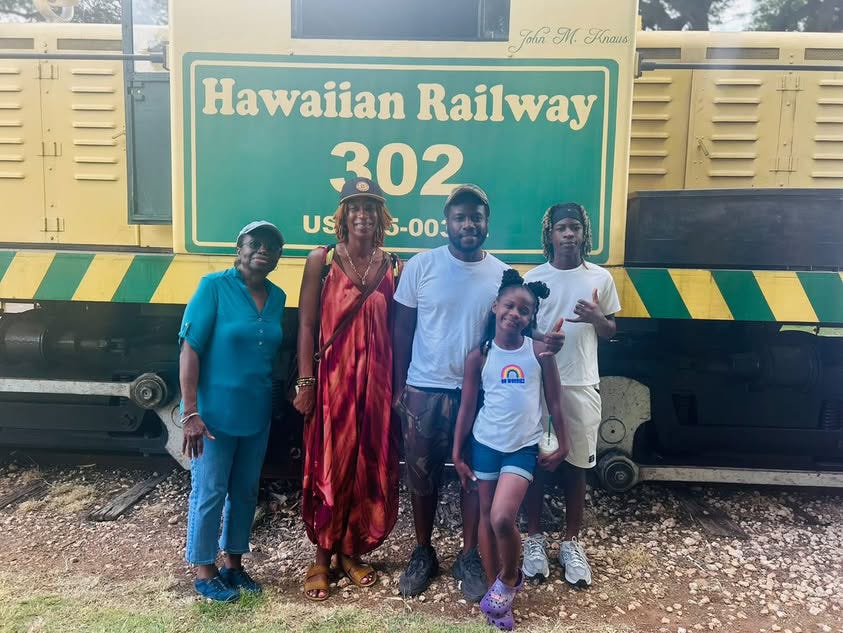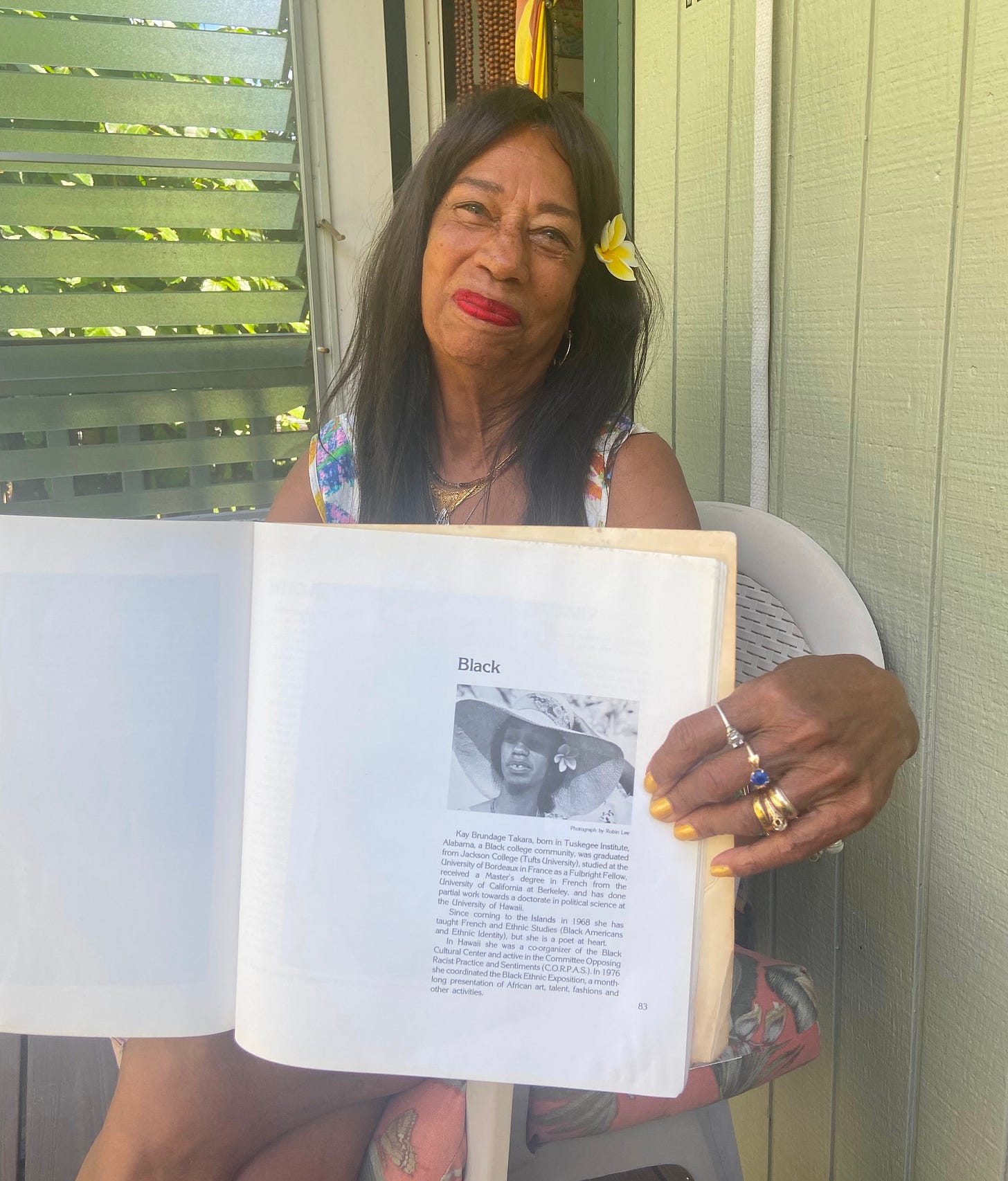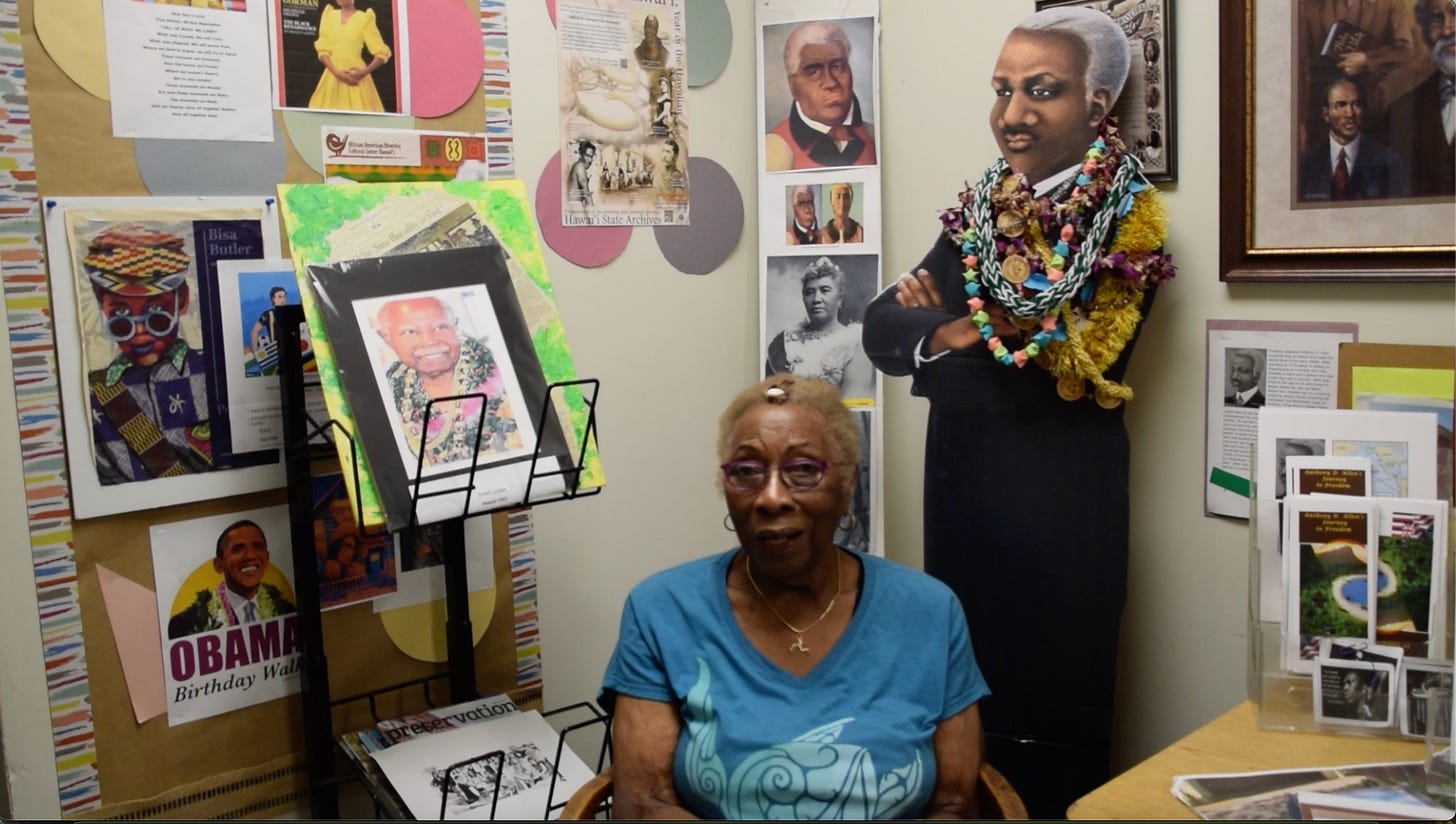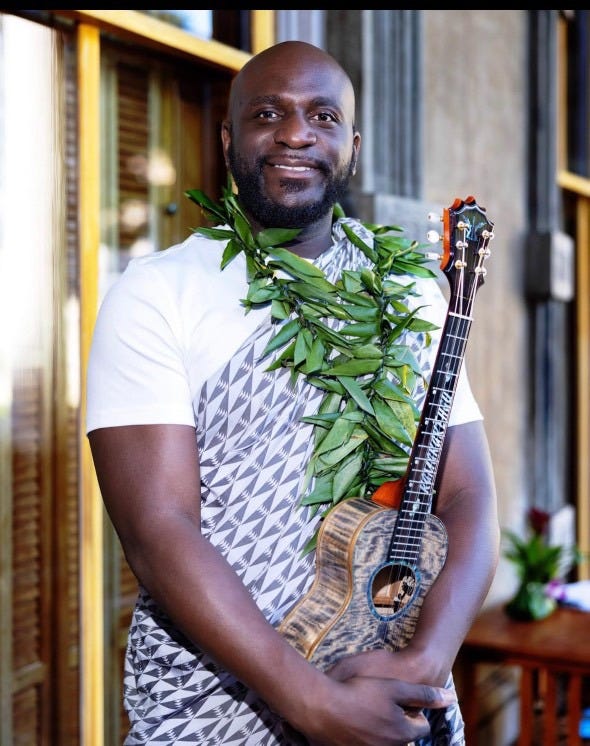A Hawaiian Escape? How Black Americans Found Refuge and Solidarity in the Kingdom
For centuries, Hawaii has been a safe haven for Black people looking to escape since the days of chattel slavery.
“And where would a fleeing Black man go if he wanted to escape?”
James Baldwin had asked the question facetiously to an audacious white reporter who had accused Baldwin of “escaping” anti-Black persecution in America by expatriating to France. Baldwin knew what we know: Anti-Blackness is a global phenomenon. Anti-Black Americanness is its own special hell. As descendants of enslaved Africans whose shame was never ours to bear, we are a reminder, and therefore, a particularly unwanted people whose very continued existence is a stubborn refusal to concede that point.
Still, since the days when we were kidnapped from Africa’s shores, we have tried to find our escape.
In 2019, Meesha Williams and her family found theirs on the Hawaiian island of Oahu. Her military husband was stationed in Honolulu, where she would complete her master’s degree in social work from the University of Hawaii. There, she felt something she’d never felt before: free.
Originally from the East Coast and the South, Williams explained, “I was raised to believe [the old adage] ‘you have to be twice as smart [as white people].’ And here, [in Hawaii] that just wasn't my experience. I just had to be,” she said.
Stepping outside of the tourist traps and resorts of places like Waikiki and experiencing Hawaii with Hawaiians indigenous to the land makes it clear what Williams means. Unlike in America, white people are a minority on the islands. After years of fighting to revive their once-outlawed native language and culture, Hawaiians have renamed streets and neighborhoods with Hawaiian names and have immersion schools where their children are taught to read, write and speak Hawaiian. Whiteness is not the obvious center. Williams felt this most strongly at work, where it was common for her to hear many different languages in a day, from Spanish to Hawaiian pidgin English. On the continent (Hawaiians do not refer to the U.S. as "the mainland"), Black Americans have long expressed the penalties we can face — at work and in life — when we don’t speak Standard English or exert energy in other ways to make white people feel more comfortable in our presence. For Williams, being in Hawaii relieved that pressure.
“I don't code switch here at all — even working in the federal [government] space,” Williams said. “I don't have to. Everyone around me, they're doing them,” she said, referring to her colleagues freely speaking their languages and dialects without shame. This freed Williams up to find out who she could be, outside of the white gaze.
“It felt like [being in Hawaii] opened up a creativity for me that I didn't know existed within me because I could focus on, what do I like, just as Meesha? Race wasn't at the forefront of my thought pattern [anymore].”
Then her husband was reassigned to the Midwest.
Suddenly, Williams found herself in the palpably tense, post-Trump racial atmosphere of 2023, back to researching school demographics so her kids wouldn’t be the only Black students or children of color there. While house-hunting in Kansas City, they noticed that if her husband was not in military uniform, they’d be received coldly, but if he were in uniform, the sellers would be more welcoming. Thinking through these intangible indignities and microaggressions again after being relatively free of that extra labor for years in Hawaii was too much to bear.
“I was like, ‘I don't want to do it anymore. I don’t want to have to teach my kids the same thing my parents taught me [about being twice as good as white people].’” Within a month, the Williams family began moving back to Oahu. “We decided we're going to come back to Hawaii and that's what we did.”
Hawaii’s first Black settlers
The Williamses aren’t alone in seeking refuge from the anti-Blackness that permeates life in the United States. In fact, for centuries, Hawaii has been a safe haven for Black people looking to escape since the days of American chattel slavery. The first Black person known to have settled in Hawaii was a man called Keakaʻeleʻele, also known as Black Jack. It’s unknown how or when Keakaʻeleʻele arrived in Hawaii, but he was recorded as residing on Oahu even before King Kamehameha I conquered Hawaii in 1796 and united the islands as one kingdom.
Anthony D. Allen, a formerly enslaved man, was another prominent Black person in Hawaii at that time. In May 1800, Allen escaped from his enslaver in Schenectady, New York, and traveled on foot and then by sea to Boston. After battling pirates and almost being returned to his former enslaver, Allen eventually prevailed and wound up on a whaling ship to Hawaii. He settled in Waikiki and ended up being the right-hand man of King Kamehameha I, and — for better or worse — founded the very first resort in the now-popular vacation destination with the six acres of land he was granted by the kingdom’s high priest. The millionaire businessman became a beloved part of the community until he died in 1835.
Betsey Stockton was another formerly enslaved person who was freed from Princeton College president, Rev. Ashbel Green, and traveled to Hawaii as a missionary in 1823. She became fluent in Hawaiian and established the first public school on Maui, now called Lahainaluna.
But during both Allen and Stockton’s lifetimes, a major change came to Hawaii. It began — as most of these colonization horror stories do — when the first Christian missionaries settled in the kingdom, in the mid-1820s. Hawaii’s Queen Ka‘ahumanu soon converted to Christianity and welcomed even more missionaries to come and convert Hawaiians. Ka’ahumanu had Hawaiian artifacts and buildings destroyed and rooted the new legal system in the Bible’s 10 Commandments. This was the beginning of the end.
Still, in the decades after Queen Ka‘ahumanu’s conversion, Black Americans continued to migrate to Hawaii, and the Hawaiian kingdom stood in solidarity with them — particularly those who were escaping slavery. In 1852, 13 years before the end of America’s Civil War, the Hawaiian Constitution enshrined into law what Hawaiians were already practicing: “Slavery shall, under no circumstances whatever, be tolerated in the Hawaiian Islands: whenever a slave shall enter Hawaiian territory he shall be free.”
Colonialism and the rise of anti-Blackness
But a powerful bloc of white American Southerners were looking to expand plantation slavery. In this context, Hawaii’s solidarity with Black Americans in particular — and Hawaiian royalty’s phenotypical resemblance to African people — were weaponized against them by white settlers and directly led to the overthrow of the kingdom and its illegal annexation to the U.S. in 1898.
By the time Hawaii’s last king, David Kalākaua, known as “The Merrie Monarch,” reinstated hula dancing and other ancient Hawaiian traditions and culture that the missionaries had stifled, there were many white settlers on the islands plotting a takeover and bringing their anti-Blackness with them. Kalākaua was no fool; he became the first sitting monarch to circumnavigate the globe on diplomatic missions to keep colonizing countries like Britain and the United States from seeing Hawaii as anything less than a sovereign kingdom. Yet when Kalākaua, his sister, Liliuokalani, who was the last queen of Hawaii, and other ali’i (tribe elders) would travel to the United States, they were racialized as Black and treated as such.
Racist white cartoonists would draw Queen Liliuokalani using anti-Black cartoon imagery as well. “They would draw her skin very dark,” explained Dr. Akiemi Glenn, a Honolulu-based linguistics and culture scholar. “She would have grotesque minstrel-style lips, really kinky, curly hair, and she's always wearing giant hoop earrings which are not a part of Hawaiian tradition, but it's an easy shorthand to make that connection [to racist images of Africans].”
It was during Liliuokalani’s reign that white landowners successfully overthrew her kingdom in 1893. “This is the 1890s,” Dr. Glenn said, contextualizing the overthrow. “This is the fever pitch of racial violence in America. Reconstruction has failed.” The same year Hawaii was annexed, white supremacists in Wilmington, North Carolina, had massacred an untold number of Black people and overthrown their duly elected government, too.
“[Americans] often talk about [Hawaiian annexation] as a ‘bloodless coup,’ but the U.S. Marines rolled up in Honolulu Harbor and they had their guns drawn on Liliuokalani. She knew that white Americans were killing brown people elsewhere without any second thought,” said Dr. Glenn. Their known terror of Black Americans on the continent allowed white Americans to successfully overthrow Hawaii’s independent government. The fates of Black and Hawaiian communities have been linked for centuries.
Yet, it is no wonder that the solidarity between our communities soon broke down after America’s illegal annexation.
With the influx of Black military workers stationed in Hawaii beginning in the 1940s in World War II, anti-Black sentiments only worsened. Around 30,000 Black Americans were stationed in or passing through Hawaii during and after World War II, significantly raising the estimated population of 200 Black people in the islands prior to the war. The white population also grew at this time, due to the military, and with that, history professor Allison Gough told Hawaii Public Radio, “we see an importation of mainland racial attitudes,” and as a result, “the relationships between African-American troops and local people began to sour.” These tensions increased, Dr. Gough said, “in part because the local population was bombarded with a barrage of negative imagery about African Americans and the mainland attitudes and structures were attempted to be imported [into Hawaii] — segregation, basically.”
At the same time, many Black soldiers in Hawaii and around the world became radicalized by their experiences outside of the continent and returned after their service empowered to fight back against white supremacist violence and segregation at home, sparking more widespread, prolonged and overt resistance to anti-Blackness that became the Civil Rights Movement of the 1950s and ’60s. As the Black Power movement grew and succeeded in many ways, Hawaiians who supported that movement were also empowered to reclaim their heritage, language and land.
“I remember the Kalama Valley movement in 1971,” said Dr. Kathryn Takara, an iconic scholar of Black history in Hawaii who, while pregnant, moved to Oahu with her white husband in 1968 to escape the racism on the continent. “[Hawaiian protestors] were wearing their black berets and black leather jackets just like [the Black] Panthers,” she said, recalling the movement to take back Kalama Valley from white land developers who were planning to turn the land into the next Waikiki. These protests sparked what’s now known as the Hawaiian Renaissance and empowered Hawaiians who were organizing to regain their sovereignty from America.
Dr. Haunani-Kay Trask, a revered kanaka maoli scholar, activist and leader of the Hawaiian sovereignty movement, was also directly impacted and inspired by the Civil Rights Movement and often cited Black revolutionaries like Malcolm X in her work. Yet her thoughts on how these movements could work in solidarity were complicated. While using the tactics of Black revolutionaries, she would at times dismiss similarities between Black and Hawaiian struggle, relating more to Indigenous Americans who were genocided and pushed to reservations.
In a paper she wrote for the Stanford Law Review, “Coalition Building Between Natives and Non-Natives,” she expressed her reticence for haoles (presumably not just white people but all non-Natives) joining Hawaiian movements because they would often take over spaces and push to become the leaders. She quoted Malcolm X throughout the paper and hammered home his general belief about unifying with other racial communities as “both a warning and an invitation.” She ended the paper by citing his thoughts on working with white people in the Civil Rights Movement :
“‘Work in conjunction with us – each of us working among our own kind.’”
Still, Dr. Trask was in community with Black activists and scholars in Hawaii. She would often carpool to the University of Hawaii with Dr. Takara, both poets and artists who bonded over their shared mistreatment as professors at the University of Hawaii. As Dr. Trask faced resistance working on the Hawaiian studies curriculum, Dr. Takara also faced resistance building the ethnic studies program. Her research building the Black studies curriculum is why Black Hawaiian history, and specifically the lives of Allen, Stockton and formerly obscured chemist Alice Ball (who discovered the treatment for leprosy) are now more widely known.
“I found [Stockton, Allen and Ball] while researching for [the book Montage: An Ethnic History of Women in Hawaii],” Dr. Takara said. “I went to the archives, I went to the mission house,” she shared of how she uncovered the records of these hidden icons for the book, which the University of Hawaii published in 1977. “All of these things were jumping off points for future Black scholars.”
Two such scholars were Marc Scruggs, who expanded on Dr. Takara’s research on Allen’s life and history, and Deloris Guttman, the founder of the only museum in Hawaii dedicated to Black history, the Obama Hawaiian Africana Museum in Honolulu. “I learned about Blacks in Hawaii only through Kathryn Takara’s [work],” Guttman said. “I used that as the base and then I put meat on the bones of the stories that she found.” An artist as well as a historian, Guttman, who moved to Honolulu in 1973 and paints under her middle name Molentia, painted Allen’s image based on missionaries’ recorded descriptions of him, and it’s still used as his definitive image.
Despite this surge of interest in the Black history of Hawaii in the 1970s, the islands were not free of anti-Blackness. Dr. Takara vividly recalls the aftermath of writing an article titled “To Be Black in Paradise: The Myth of Racial Harmony in Hawaii” for Honolulu magazine.
“I got assassinated,” Dr. Takara laughed, remembering the many complaining letters to the editor that were written after publication, which threatened her career.
The anti-Blackness didn’t stop. In 1997, Guttman founded the Black history museum, originally named African American Diversity Culture Center Hawaii, in response to a young Black child who had experienced anti-Black abuse from a teacher at school. “My way of helping [to stop anti-Black abuse] was to do a sensitivity workshop [with the school] to share our culture and history with the teachers so they could learn about people of African descent,” Guttman said. This then led to her founding the museum. Still, the “myth of racial harmony” continues as recently as 2019 with a misguided piece in the New York Times suggesting that moving to Hawaii would make someone “less racist.” Dr. Glenn, who came to Hawaii decades ago from Virginia, lambasted the piece. “There is anti-Blackness in Hawaii, that's not up for debate,” she said.
Kamakakēhau Fernandez has also experienced it, despite growing up immersed in Hawaiian culture and community from birth. In a closed adoption in Little Rock, Arkansas, Fernandez was adopted by a Hawaiian woman when he was 16 weeks old and speaks the language fluently, dances hula and is an award-winning singer in the falsetto tradition. Though he is beloved in many Hawaiian circles, there have been times, he shared, that when he’s practicing Hawaiian protocols in spaces reserved only for kanaka maoli (native Hawaiians), he’s assumed to be interloping because he’s Black.
“[Even in full, ceremonial dress], there was an uncle [a term of respect for Hawaiian elders] that yelled at me, ‘Get off of our beach!’ and I'm like, ‘I’m Hawaiian,’” Fernandez said.
Experiences like this, along with the loss of his mother in 2019, spurred Fernandez to seek out his Black American ancestry in Little Rock and document the journey in a film that Dr. Glenn is producing. “Obviously, I have my [Hawaiian] family [that supports me],” Fernandez said. Even his uncle, Maui legend and Ritz Carlton cultural adviser Clifford Naeole, has asked him why he needs to leave Hawaii to find himself when there is so much Black American history there. “But [for some other Hawaiians] how we connect is very limited,” Fernandez said. “I feel a little, I guess, intimidated of Hawaii, like do I really fit in with you guys?”
Black residents who have come there without being agents of the occupying military or state are still often assumed to be, even though less than 3% of the military population in the islands is Black. For those who join, the military is one of the clearest paths Black people have to a livable income, a college education and world travel. Still, Dr. Glenn, who founded the non-profit organization The Pōpolo Project to build solidarity between Black people and Hawaiians, suggests that Black people who come there ask themselves crucial questions:
“In what ways are we participating in the structures that reinforce harm, for example the military occupation? And in what ways are we disrupting that and in what ways are we just being honest with ourselves that sometimes coming to a place where we can feel at home requires people whose home it is to not feel like they're welcome?” Comfortability and upward mobility in the context of militarism, capitalism and imperialism come at a cost.
Particularly since the beginning of the pandemic, many Hawaiians have called on non-natives to stop vacationing in Hawaii — let alone moving there. These calls have only grown as Maui recovers from the 2023 Lahaina fires that were the direct result of the government’s prioritization of tourism and the rerouting of crucial water sources away from Lahaina. Though the housing crisis has been exacerbated by the fires, with activists successfully pushing Governor Josh Green into curbing the devastating short-term rental market, kanaka have long-since been priced out.
The new colonizers
White billionaires like Meta founder Mark Zuckerberg, who has bought 1,600 acres on Kauai and is reportedly building a $100 million compound with an apocalypse-level bunker, have led the charge on the neo-colonization of Hawaii. But Black American billionaires also contribute to the problem. Oprah Winfrey reportedly owns 1,000 acres on Maui, and Byron Allen, whose oceanfront Maui property was the highest sale on the island in early 2018, bolsters a market that makes it increasingly difficult for native Hawaiians to afford to live in their own occupied homeland. As a result, CBS reported, 15,000 native Hawaiians are forced out every year, with more Hawaiians now living outside of Hawaii than on the islands.
It’s from that context that Winfrey received backlash in 2023, even when attempting to help. She and Black-Polynesian actor Dwayne “The Rock” Johnson created a fund to give victims of the Lahaina wildfires cash on a monthly basis to help them recover. But the Hollywood one-percenters were widely criticized for not self-financing the fund and choosing instead to donate $10 million while encouraging everyday Americans — more than 60% of whom live paycheck to paycheck — to contribute to the fund as well.
At the highest echelon of global power, our first Black president and first Hawaii-born president Barack Obama expanded the Pacific Remote Islands Marine National Monument to be the largest marine monument in the world. Though hailed in mainstream media as an environmental conservation effort, the Hawaii Independent derided Obama’s unilateral act as “Blue-washing the colonization and militarization of our ocean.”
“These monuments violate the rights of indigenous peoples by separating us from our sacred spaces,” Craig Santos Perez wrote in 2014 for the now-defunct paper, detailing how these lands and surrounding oceans become the property of the federal government and require indigenous people to ask permission to continue their ancient practices on what is now federal property controlled by the military. These colonial acts of separating indigenous people from their land, ocean and resources have only strengthened the fight for Hawaiian sovereignty.
In that spirit, Hawaiian activists — alongside Black residents and other marginalized communities — have been protesting to free Palestine from Israeli occupation and genocide. In 2024, Dr. Glenn’s The Popolo Project partnered for an event with the Hawaii branch of Jewish Voice for Peace, the largest Jewish anti-Zionist organization fighting for Palestinian liberation in the world. Hawaiian activists successfully pressured their state legislature into passing a resolution demanding then-President Biden to call for a permanent ceasefire in Gaza — the first state to do so. They understand that the United States, Europe and Israel’s displacement and genocide of Palestinians has the same white supremacist colonial roots as their own.
“We’ve been denationalized as Hawaiians and we’re watching that happen to the Palestinians and it’s not OK,” pastor and activist Kekaula Kānealiʻi said to her state representative David A. Tarnas in a viral video as she and other activists confronted him in his office about co-opting the Hawaiian word “kuleana” which translates to “responsibility” to avoid calling for a ceasefire. “Please do not weaponize our language to support a genocide,” she told him.
Though these efforts were eventually successful, so many battles remain. Most of the editorial staff of the largest local newspapers are not kanaka. Neither are its top government leaders, from the governor to the U.S. senators and representatives. Allen’s Allen Media Group owns Honolulu’s ABC affiliate station KITV. The Air Force recently proposed building six telescopes on the sacred kanaka ground, Haleakalā, on Maui. Just as the Black community of Flint, Michigan, has been without clean water since April 2014, Oahu residents continue to suffer from the U.S. Navy spilling jet fuel into the water supply at Red Hill in 2021, poisoning 6,000 people and continuing to threaten 400,000 people today.
While Oahu’s Cop City proposal has seemingly stalled in the legislature, Black activists are still fighting Cop Cities in their neighborhoods across America, with a national spotlight on the Atlanta Stop Cop City movement. These Cop Cities are modeled after the Israeli Urban Warfare Training Center nicknamed “Mini Gaza.” The venn diagram is a circle. In the face of these unending traumas and joint struggles, many Black people in Hawaii continue their efforts to rebuild the solidarity they and indigenous Hawaiians once enjoyed in the islands.
Attorney Leslee Matthews, a Black advocate for (and product of) Black-Hawaiian solidarity, has been providing pro bono legal services and care for the unhoused even prior to the devastating Lahaina fires. In their wake, her Roots Reborn Lahaina organization mobilized to secure housing, necessities, health and legal services for displaced Hawaiians. “My kanaka family really instilled in me what’s important,” said Matthews, who grew up in Kihei, Maui and became close with her kanaka neighbors. She’s motivated by what her kanaka Aunty Jill used to say to her in the mornings before school: “Go make Maui a better place!”
Sheka, a Black former Navy submariner who was stationed in Hawaii, was also inspired to work towards solidarity after he returned there to go to college on the G.I. Bill. In college, he learned how his military service contributed to the oppression of Hawaiians while studying their history and culture. The enlightening education helped him see how America’s oppression of Black people intertwined with Hawaiians’ oppression. “I wanted to do anything I could to give back to this place that was awakening me,” he said.
That’s how he ended up protesting alongside kanaka maoli against the proposed construction of the Thirty Meter Telescope on the big island’s sacred Mauna Kea. Even when he felt, at times, the suspicions of the kupuna at his presence there, he recentered himself with a mantra: “I know why I'm here; I'm here to represent [Black] culture and I'm here to help in any way possible because [we have] the same fight,” he said. He moved back to the West Coast soon after the experience.
“Hawaiian people are also suffering under white supremacy,” Dr. Glenn said of how she teaches community-building through The Pōpolo Project. Named after a sacred medicinal plant with black berries that became a Hawaiian nickname for Black people before it became offensive, the linguist has reclaimed pōpolo by reminding people of the plant’s healing properties and significance in Hawaiian culture — an example of centuries of solidarity. “There's an opportunity here for us as Black folks and native folks to have a conversation outside of a white supremacist frame,” Dr. Glenn says of wrestling with the word. “I think that alone is healing.”
Though Williams hasn’t experienced any hostilities with Hawaiians, she understands the tensions that exist. “Dealing with the idea that Black Americans aren't wanted [somewhere] is not a new front for us because where are we wanted? We've learned to navigate that,” she said. But her intentions in Hawaii remain rooted in community building, having peace of mind and providing the safest childhood for her children.
“I'm not trying to take nothing from you. I come in peace, with the spirit of aloha,” she said. “We can build something great together.”










Thank you for that insight, Brooke.